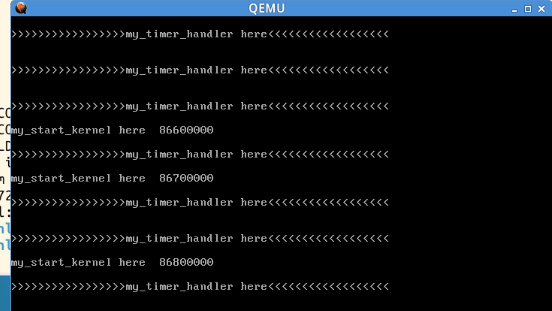学号351
原创作品转载请注明出处 + https://github.com/mengning/linuxkernel/
-
mykernel简介
mykernel是由孟宁老师建立的一个用于开发您自己的操作系统内核的平台,基于Linux Kernel 3.9.4 source code mykernel的源代码 https://github.com/mengning/mykernel ,
你可以按照上面的指南部署到你的操作系统,也可以使用实验楼提供的虚拟机,该虚拟机上已经部署好这个平台,只需按照实验二的步骤即可运行这个平台框架。本文实验完成于实验楼。
具体操作:
cd LinuxKernel/linux-3.9.4
rm -rf mykernel
patch -p1 < ../mykernel_for_linux3.9.4sc.patch
make allnoconfig
make
qemu -kernel arch/x86/boot/bzImage
就可以在qemu上看到运行结果
如图:
可以看出:
>>>>>>>>>>>>>>>my_timer_handler here<<<<<<<<<<和>>>>>>>>>>>>>>>my_start_kernel here<<<<<<<<<<<<<<<<会无限循环输出。
接着查看mymian.c和myinterrupt.c文件

其中的my_start_kernel函数中有一个循环,不断输出my_start_kernel here

有一个会被时钟中断周期调用的函数my_timer_handler。在这个函数里,会输出类似>>>>>my_timer_handler here<<<<< 的字符串。
这两个函数的输出就是我们在窗口看到的内容,
当mykernel系统启动后,就会调用my_start_kernel函数(满足条件i%10000==0),周期性调用my_timer_handler函数
-
实现一个简单的时间片轮转多道程序
接下来我们通过扩展my_start_kernel和my_timer_handler函数,模拟了一个基于时间片轮转的多道程序。
1,实验步骤:
(1)从实验用的源代码,https://github.com/mengning/mykernel通过git-clone命令下载到mykernel平台。主要就这三个文件:mypcb.h,myinterrupt.c和mymain.c
(2)回到LinuxKernel/linux-3.9.4文件夹,使用下面的命令编译、运行
具体操作如下:
cd ../ #回到linux-3.9.4目录
make allnoconfig
make
qemu -kernel arch/x86/boot/bzImage
2,运行结果如图:

3,源码分析
mypcb. h:进程控制块PCB结构体定义。
/** linux/mykernel/mypcb.h** Kernel internal PCB types** Copyright (C) 2013 Mengning**/#define MAX_TASK_NUM 4
#define KERNEL_STACK_SIZE 1024*2 # unsigned long
/* CPU-specific state of this task */
struct Thread { //用于保存erp,espunsigned long ip;unsigned long sp;
};typedef struct PCB{int pid;volatile long state; /* -1 unrunnable, 0 runnable, >0 stopped */unsigned long stack[KERNEL_STACK_SIZE];/* CPU-specific state of this task */struct Thread thread;unsigned long task_entry;struct PCB *next;
}tPCB;void my_schedule(void);其中各个字段含义如下:
pid:进程号
state:进程状态,在模拟系统中,所有进程控制块信息都会被创建出来,其初始化值就是-1,如果被调度运行起来,其值就会变成0
stack:进程使用的堆栈
thread:当前正在执行的线程信息
task_entry:进程入口函数
next:指向下一个PCB,模拟系统中所有的PCB是以链表的形式组织起来的。
my_schedule:函数声明,在my_interrupt.c中实现,在mymain.c中的各个进程函数会根据一个全局变量的状态来决定是否调用它,从而实现主动调度。
mymain.c: 初始化各个进程并启动0号进程。
/** linux/mykernel/mymain.c** Kernel internal my_start_kernel** Copyright (C) 2013 Mengning**/ #include <linux/types.h> #include <linux/string.h> #include <linux/ctype.h> #include <linux/tty.h> #include <linux/vmalloc.h>#include "mypcb.h"tPCB task[MAX_TASK_NUM]; tPCB * my_current_task = NULL; volatile int my_need_sched = 0;void my_process(void);void __init my_start_kernel(void) {int pid = 0;int i;/* Initialize process 0*/task[pid].pid = pid;task[pid].state = 0;/* -1 unrunnable, 0 runnable, >0 stopped */task[pid].task_entry = task[pid].thread.ip = (unsigned long)my_process;task[pid].thread.sp = (unsigned long)&task[pid].stack[KERNEL_STACK_SIZE-1];task[pid].next = &task[pid];/*fork more process,每个进程都有自己的堆栈,并指向下一个进程 */for(i=1;i<MAX_TASK_NUM;i++){memcpy(&task[i],&task[0],sizeof(tPCB));task[i].pid = i;//*(&task[i].stack[KERNEL_STACK_SIZE-1] - 1) = (unsigned long)&task[i].stack[KERNEL_STACK_SIZE-1];task[i].thread.sp = (unsigned long)(&task[i].stack[KERNEL_STACK_SIZE-1]);task[i].next = task[i-1].next;task[i-1].next = &task[i];}/* 从第0个进程开始 */pid = 0;my_current_task = &task[pid];asm volatile("movl %1,%%esp\n\t" /* set task[pid].thread.sp to esp */"pushl %1\n\t" /* push ebp */"pushl %0\n\t" /* push task[pid].thread.ip */"ret\n\t" /* pop task[pid].thread.ip to eip */: : "c" (task[pid].thread.ip),"d" (task[pid].thread.sp) /* input c or d mean %ecx/%edx*/); } int i = 0;void my_process(void) { while(1){i++;if(i%10000000 == 0){printk(KERN_NOTICE "this is process %d -\n",my_current_task->pid);if(my_need_sched == 1) //ny_need_sched=1时才会调度{my_need_sched = 0;my_schedule();}printk(KERN_NOTICE "this is process %d +\n",my_current_task->pid);} } }
系统启动后,最先调用函数my_start_kernel,在这个函数里完成了0号进程的初始化和启动,并创建了其它的进程PCB,以方便后面的调度。在模拟系统里,每个进程的入口函数都是 my_process,在执行的时候,会打印出当前进程的 id。
另外,在 my_process 会检查一个全局标志变量 my_need_sched,一旦发现其值为 1 ,就调用 my_schedule 完成进程的调度。
myinterrupt.c:时钟中断处理和进程调度算法。
/** linux/mykernel/myinterrupt.c** Kernel internal my_timer_handler** Copyright (C) 2013 Mengning**/ #include <linux/types.h> #include <linux/string.h> #include <linux/ctype.h> #include <linux/tty.h> #include <linux/vmalloc.h>#include "mypcb.h"extern tPCB task[MAX_TASK_NUM]; extern tPCB * my_current_task; extern volatile int my_need_sched; volatile int time_count = 0;/** Called by timer interrupt.* it runs in the name of current running process,* so it use kernel stack of current running process*/ void my_timer_handler(void) { #if 1if(time_count%1000 == 0 && my_need_sched != 1) //设置时间片大小,时间片用完设置调度标志{printk(KERN_NOTICE ">>>my_timer_handler here<<<\n");my_need_sched = 1;} time_count ++ ; #endifreturn; }void my_schedule(void) {tPCB * next;把当前tPCB * prev;if(my_current_task == NULL || my_current_task->next == NULL){return;}printk(KERN_NOTICE ">>>my_schedule<<<\n");/* schedule */next = my_current_task->next; //把当前进程的下一个进程赋值给nextprev = my_current_task;if(next->state == 0)/* 下一个进程正在执行*/{ my_current_task = next; printk(KERN_NOTICE ">>>switch %d to %d<<<\n",prev->pid,next->pid); /* switch to next process */asm volatile( //切换进程"pushl %%ebp\n\t" /* save ebp */"movl %%esp,%0\n\t" /* 把当前进程的esp赋给prev->thread.sp,保存*/"movl %2,%%esp\n\t" /* 把下一进程的next->thread.sp赋给esp */"movl $1f,%1\n\t" /* save eip */ "pushl %3\n\t" "ret\n\t" /*把下一进程的next->thread.ip进栈*/"1:\t" /* 下一进程开始执行*/"popl %%ebp\n\t": "=m" (prev->thread.sp),"=m" (prev->thread.ip): "m" (next->thread.sp),"m" (next->thread.ip)); } return; }
内核周期性调用my_timer_handler 函数,每调用1000次,就去将全局变量my_need_sched的值修改为1,通知正在执行的进程执行调度程序my_schedule。在my_schedule函数中,完成进程的切换。
-
总结
经过该次试验,我们对操作系统的进程调度机制和中断机制有了更新的认识,也对之前学的内容作了一次复习。Linux操作系统由内核来实现它的具体工作的,系统通过调用fork()函数来创建的一个进程,他先是将先前CPU正在运行的进程的进程上下文保存在内核态堆栈中,包括有eip,esp,ebp,cs等寄存器的数据;然后加载创建的进程的上下文信息到相应的寄存器中,运行当前新建进程;运行完毕后根据系统的调度继续执行相应的进程。同时,操作系统以一种中断的机制实现与用户的交互。操作系统中的IDT描述好各个中断对应的处理程序,当发生相对应的中断时,由硬件来实现中断信号的传递,CPU接收到相应的IRQ信号后,由操作系统如调度进程那样调度相应的处理程序,来完成相应的中断请求,实现与用户的交互。

...)



:继承QRunnable类)
——Promise对象)








基础知识1)



